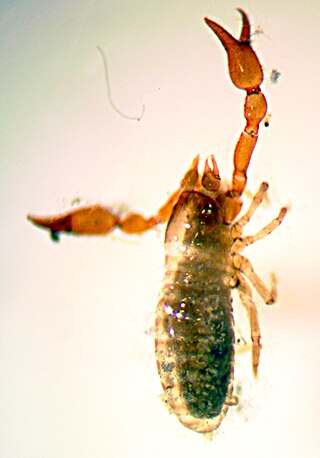
Fruit syrups or fruit molasses are concentrated fruit juices used as sweeteners.

The Halmahera cuckooshrike or Halmahera cicadabird is a species of bird in the family Campephagidae. It is found in the northern Maluku Islands.

Buccinum parvulum is a species of sea snail, a marine gastropod mollusk in the family Buccinidae, the true whelks.

Adoketophyton is a genus of extinct vascular plants of the Early Devonian. The plant was first described in 1977 based on fossil specimens from the Posongchong Formation, Wenshan district, Yunnan, China. These were originally named Zosterophyllum subverticillatum; later the species was transferred to a new genus as Adoketophyton subverticillatum. One cladistic analysis suggested that it is a lycophyte, related to the zosterophylls. Other researchers regard its placement within the vascular plants as uncertain.
Carenum is a genus of beetles in the family Carabidae, containing the following species:
Carenum froggatti is a species of ground beetle in the subfamily Scaritinae. It was described by Sloane in 1897.
Carenum imitator is a species of ground beetle in the subfamily Scaritinae. It was described by Sloane in 1897.
Carenum versicolor is a species of ground beetles in the subfamily Scaritinae. It was described by Sloane in 1897. It is found in Australia.
Carenum fugitivum is a species of ground beetle in the subfamily Scaritinae. It was described by Blackburn in 1888.
Carenum browni is a species of ground beetle in the subfamily Scaritinae. It was described by Sloane in 1916.
Carenum brevicolle is a species of ground beetle in the subfamily Scaritinae. It was described by Sloane in 1894.
Carenum breviforme is a species of ground beetle in the subfamily Scaritinae. It was described by Henry Walter Bates in 1874.
Carenum viridicolor is a species of ground beetle in the subfamily Scaritinae. It was described by Sloane in 1895.
Carenum janthinum is a species of ground beetle in the subfamily Scaritinae. It was described by William John Macleay in 1883.
Carenum rutilans is a species of ground beetle found commonly in Australia in the subfamily Scaritinae. It was described by Sloane in 1907.
Carenum planipenne is a species of ground beetle in the subfamily Scaritinae, found in Australia. It was described by William John Macleay in 1873.

Microbisium parvulum is a species of pseudoscorpion in the family Neobisiidae.
Tetropium parvulum, the northern spruce borer, is a species of long-horned beetle in the family Cerambycidae. It is found in North America.

Synema parvulum is a species of crab spider in the family Thomisidae. It is found in the United States and Mexico.
Anisolophus is an extinct genus of proterotheriid from the Early to Middle Miocene of Argentina. The genus was named by Burmeister in 1885 to accommodate the species Anchitherium australe, which they had named earlier in 1879. Soria then referred the species Licaphrium floweri and Anisolophus minisculus to the genus, making Licaphrium, named in 1887 by Florentino Ameghino, a junior synonym of the genus. Both A. australis and A. floweri are known from the Santacrucian age Santa Cruz Formation, while A. minisculus is known from the Collón Curá Formation.





